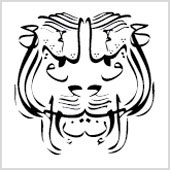Design Course
Lucknow Calligraphy
The decorative art of writing
by
Raw Material: Quitabat is mainly done on paper or stone. Therefore artists use different handmade paper and precious and semi-precious stone to do the calligraphy. The main used stone is Jade, this stone is good for the heart, and therefore, verses written on it are highly respected. Artists use fine handmade paper which is either imported from different countries or made in India using different techniques and materials.
Tools: Calligraphy is done either by carving on stone or by writing on paper. For carving various carving tools like chisels and hammers are used. These tools were traditionally made by the artists themselves according to their needs. With the change in time and with easy availability calligraphers now use industrial tools which are either hand or machine operated. For writing on paper traditionally the artist uses a stylus made out of Sarkanda, (Saccharum spontaneous) also called as elephant grass. These styluses are traditionally called as Qulam, which are useful in achieving desired results. It helps in obtaining a perfect balance between the structure and flow of various circular word forms. Different types of Qulam used are:
• Kamish Qulam (made out of Sarkanda)
• Java Qulam (after the name of the island Java)
• Dashti Qulam
• Jali Qulam
The tip of the Sarkanda is cut at an angle mostly at 45 degrees. The angle decides the thickness of the lines. Sarkanda pens were replaced by G-nibs and now with the availability of different calligraphy pens the traditional Qulams are losing their hold.




